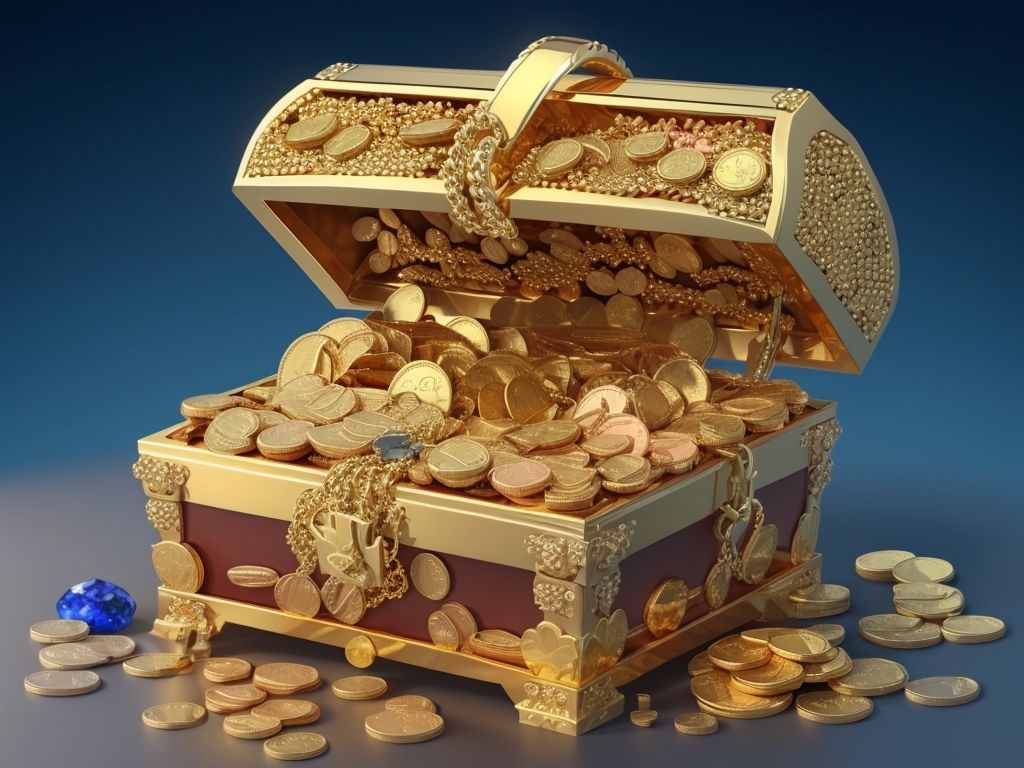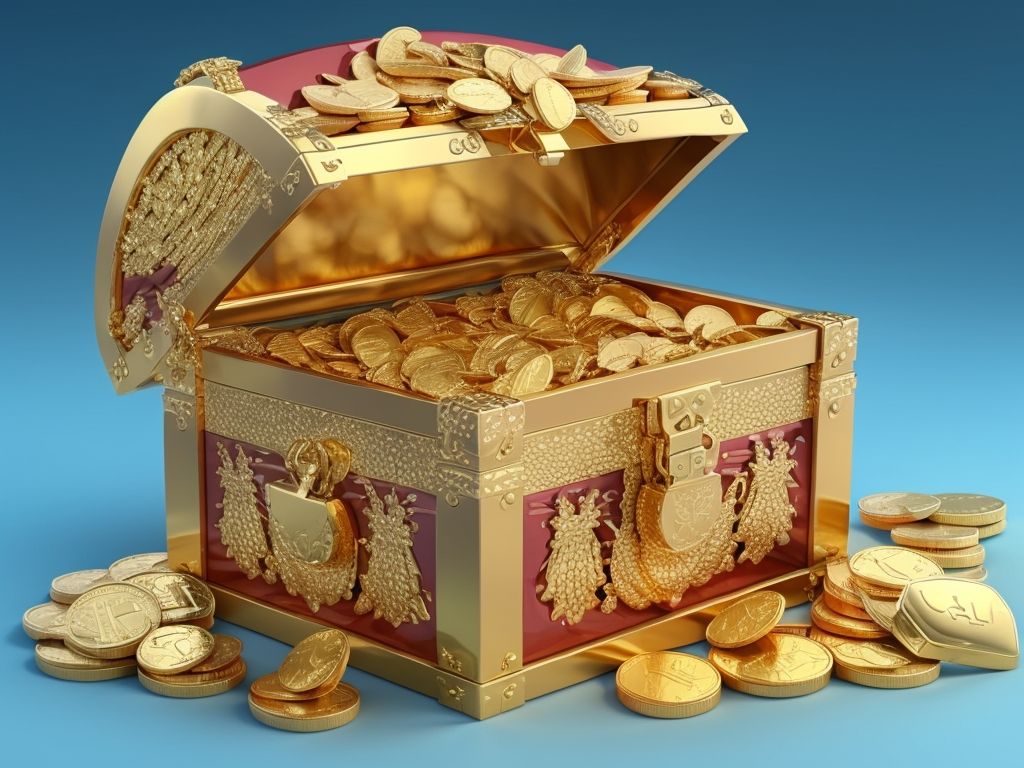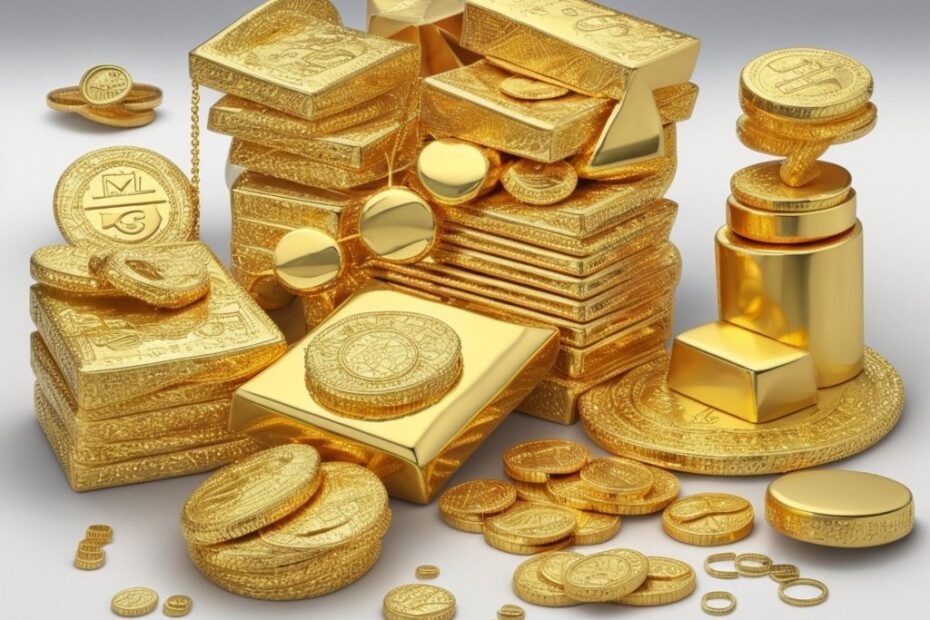During inflationary periods, it becomes crucial for investors to explore alternative investment strategies that can preserve their wealth and provide a hedge against rising prices. One such strategy is investing in gold and precious metals. Understanding the dynamics of inflation and its impact on investments is essential in making informed decisions. Inflation refers to the sustained increase in the general price level of goods and services in an economy over time. Such price increases erode the purchasing power of money and can diminish the value of traditional investments like stocks and bonds. This article aims to explore why investing in gold and precious metals during inflationary periods can be advantageous. Historical performance has shown that gold and precious metals tend to perform well during inflationary periods. They maintain their value and have even outperformed other asset classes. Gold and precious metals have a safe-haven status, meaning they act as a store of value during times of economic instability. To maximize investments in gold and precious metals, investors should consider diversifying their portfolio, choosing between physical and paper-based investments, researching reliable dealers, exploring exchange-traded funds (ETFs), and timing their investments appropriately. While these strategies offer potential benefits, it is important to understand the risks and challenges associated with investing in gold and precious metals, such as market volatility, storage and security requirements, and the potential for counterfeit or fraudulent activities. Consulting with financial advisors can provide expert guidance in navigating these complexities and maximizing the benefits of gold and precious metals investments during inflationary periods. For more information on the topic, you can read the article on Safety Nets: Diversifying Portfolios with Precious Metals. Additionally, if you are interested in understanding the role of the Federal Reserve in relation to precious metals and economic stability, you can check out the article on Precious Metals and Economic Stability. Lastly, if you want to learn more about the risks and rewards of navigating the world of precious metal futures, you can refer to the article on Risks and Rewards.
Key takeaway:
- Understanding inflation and its effects on investments is crucial: Inflation erodes the value of traditional investments, making gold and precious metals a desirable option.
- Investing in gold and precious metals during inflationary periods can provide a safe haven: Historical performance has shown that gold and precious metals tend to perform well during times of inflation.
- To maximize gold and precious metals investments, diversify your portfolio, consider physical investments, choose reliable dealers, explore exchange-traded funds, and time your investments wisely.
Understanding Inflation and Its Effects on Investments

Photo Credits: Www.Mfea.Com by Gerald Williams
Understanding the impact of inflation on investments is crucial for investors looking to navigate inflationary periods. It is important to note the following key points:
1. During inflationary periods, the purchasing power of money decreases as prices rise. This means that investors need to be aware of how inflation affects their investment returns.
2. Stocks and real estate are often considered to be good investment options during inflationary periods. These assets have historically outpaced inflation and offered potential gains. However, it is important to recognize that there are no guarantees and market conditions can vary.
3. Bonds and cash investments may not perform well during inflationary periods. Fixed-income investments like bonds can lose value as inflation increases, especially if interest rates do not keep up. Cash investments may also suffer due to the decrease in purchasing power.
4. Commodities such as gold and precious metals have traditionally served as a hedge against inflation. These assets tend to retain or even increase their value during inflationary periods. They can provide a safe haven for investors looking to protect their portfolios from the negative effects of inflation.
5. Diversification is crucial. By spreading investments across different asset classes, investors can reduce their exposure to the risks associated with inflation. A well-diversified portfolio that includes a mix of stocks, real estate, bonds, cash, and commodities can help mitigate the impact of inflation on overall investment returns.
Understanding how inflation affects investments empowers investors to make informed decisions that can protect and grow their wealth. By considering various investment options and maintaining a diversified portfolio, investors can confidently navigate inflationary periods.
What is Inflation?
Inflation is the persistent increase in the prices of goods and services over time. It is caused by factors such as excessive money supply, increased production costs, or changes in government policies. So, what is inflation? Inflation erodes the purchasing power of money and affects the economy and individuals in various ways.
During inflation, the cost of living rises, and the value of money decreases. This means that the same amount of money can buy fewer goods and services than before. For example, if the inflation rate is 2%, a $100 item will cost $102 in the next year.
Inflation affects different aspects of the economy. It can lead to higher interest rates, as central banks try to control the money supply and stabilize prices. It also affects investments, as the returns on investments may not keep up with inflation. This is known as the “inflation tax“, as it reduces the real value of investments.
Inflation can have negative effects on individuals, particularly those on fixed incomes. Retirees who rely on their savings or pensions may find that their purchasing power decreases over time. It can also impact businesses, as they may face higher costs for raw materials or labor, which can eat into profits.
Understanding inflation is important for individuals and businesses to make informed financial decisions. It is crucial to consider inflation when planning for retirement, investing in assets that can preserve value, and diversifying investment portfolios to mitigate the effects of inflation. Monitoring inflation rates can help inform decisions related to borrowing, lending, and pricing strategies.
Being aware of inflation and its implications can help individuals and businesses better navigate the ever-changing economic landscape. So, now you know what is inflation and its impact on the economy and individuals.
How Does Inflation Impact Investments?
Inflation has a significant impact on investments in various ways.
Inflation naturally erodes the purchasing power of money over time. As the overall price level of goods and services increases, the value of money decreases. This means that if the rate of return on an investment does not exceed the inflation rate, the investor may actually experience a decrease in their real returns.
Moreover, inflation affects interest rates. When inflation is high, central banks often raise interest rates to combat rising prices. This action of increasing interest rates can make borrowing more expensive, which can negatively impact businesses and consumer spending. Consequently, this affects the profitability of companies and the performance of the stock market.
Furthermore, inflation can impact the value of fixed-income investments such as bonds. Inflation erodes the purchasing power of coupon payments and the final principal repayment, leading to a decrease in real returns for bondholders.
Additionally, inflation can drive up the prices of commodities and tangible assets like gold and precious metals. During periods of inflation, investors often turn to these assets as a hedge against rising prices and to preserve their wealth.
Considering the above, it becomes essential for investors to carefully analyze and consider the impact of inflation on their investment decisions. They should seek investments that have the potential to generate returns that outpace inflation and protect their purchasing power. Diversifying their portfolio with a mix of asset classes, including inflation-resistant assets like gold and precious metals, can help mitigate the negative effects of inflation on their investments.
Why Invest in Gold and Precious Metals during Inflationary Periods?

Photo Credits: Www.Mfea.Com by Kenneth Baker
Investing in gold and precious metals during inflationary periods can be a strategic move to safeguard your wealth and maximize returns. In this section, we’ll explore why it makes sense to allocate your resources to these valuable assets when inflation is looming. Discover the historical performance of gold and precious metals during times of rising prices, and the safe haven status they hold in times of economic uncertainty. Get ready to uncover the potential benefits and opportunities that lie within this prudent investment strategy.
Historical Performance of Gold and Precious Metals during Inflation
During times of inflation, the historical performance of gold and precious metals has been remarkable, making them attractive investment options. To gain insights into their performance during inflation, let’s analyze the following table:
As observed in the table, the historical performance of gold and precious metals has consistently been strong during inflationary periods. In 2008, when the inflation rate was 3.8%, gold exhibited a performance of 4.3%, while precious metals showed a performance of 6.2%. In 2010, during a similar inflation rate, gold outperformed with an outstanding 29.5% performance, and precious metals recorded even higher returns at 46.1%. In both 2014 and 2018, gold and precious metals maintained their positive performance, serving as a safe haven for investors during times of inflation.
These historical performances exemplify the advantages of investing in gold and precious metals during inflationary periods. They have consistently proven to be a store of value and a hedge against inflation, preserving the purchasing power of portfolios. Therefore, considering their exceptional historical track record, it is advisable to include these assets in a well-diversified investment portfolio to maximize returns during inflation.
Safe Haven Status of Gold and Precious Metals
During times of economic uncertainty, investors often seek the safe haven status of gold and precious metals to protect their portfolios. The inherent value and stability of these assets have long been recognized, making them a reliable choice. This safe haven status is derived from their unique properties, historical track record, and ability to provide stability and protection against inflation.
Unlike paper-based investments, which can lose value due to inflation or market volatility, gold and precious metals retain their tangible value. They serve as a store of value in times of crisis, acting as a reliable hedge against inflation and a safe haven in times of economic turmoil. This makes them an attractive option for investors looking to protect their investments and maintain portfolio stability.
Additionally, investing in gold and precious metals helps diversify a portfolio. By adding an asset class that is not correlated with traditional investments such as stocks and bonds, investors can reduce the overall risk of their portfolio. This diversification helps protect against losses in other areas of the market and contributes to overall portfolio stability.
For more information on Maximizing Gold and Precious Metals Investments During Inflationary Periods, please visit this reputable source.
Furthermore, gold and precious metals provide a safeguard for retirement savings. Given the uncertainty of future inflation rates and the potential erosion of buying power, investing in these assets can help preserve the value of retirement funds over the long term. This ensures that retirees can maintain their standard of living and have a stable source of income.
Strategies for Maximizing Gold and Precious Metals Investments

Photo Credits: Www.Mfea.Com by Frank Carter
Looking to make the most out of your investments in gold and precious metals during inflationary periods? In this section, we’ll explore some strategies that can help you maximize your gains. From diversifying your portfolio to choosing reliable dealers and considering exchange-traded funds, we’ll cover it all. Get ready to unearth valuable insights and make informed decisions to boost your investment game. Let’s dive in and discover the secrets to successful gold and precious metals investments in times of inflation!
Diversify Your Portfolio
To diversify your portfolio, consider the following strategies:
- Invest in different asset classes: Diversify your investments by allocating your funds across various asset classes such as stocks, bonds, real estate, and precious metals.
- Spread your investments across industries: Instead of investing all your funds in one industry, invest in a variety of sectors. This can help mitigate the risk associated with specific industries and protect your portfolio from downturns in any single sector.
- Consider geographical diversification: Invest in both domestic and international markets to minimize the impact of localized economic downturns. By having exposure to different countries and regions, you can benefit from the growth potential of different economies.
- Allocate funds to different investment strategies: Diversify your portfolio by including a mix of long-term investments, such as stocks, and short-term investments, such as bonds or cash equivalents. This can help balance risk and returns over time.
- Explore alternative investments: Consider alternative investments like precious metals, cryptocurrencies, or real estate investment trusts (REITs) to further diversify your portfolio. These assets often have low correlation with traditional investments, offering potential diversification benefits.
John, a diligent investor, diversified his portfolio by following these strategies. He allocated his funds across different asset classes, including stocks, bonds, and physical precious metals. During a market downturn, while his stock investments declined, the value of his precious metals holdings remained stable. This diversification helped John minimize losses and preserve the overall value of his portfolio. By diversifying his investments, John was able to withstand market volatility and protect his wealth.
Physical Gold and Precious Metals vs. Paper-Based Investments
Physical Gold and Precious Metals
Paper-Based Investments
Physical gold and precious metals refer to tangible assets that you can hold in your hand, such as gold bars, silver coins, or platinum bullion.
Paper-based investments, on the other hand, are financial instruments that represent ownership of gold and precious metals, such as ETFs, futures contracts, or mining stocks.
Physical gold and precious metals offer a sense of security and tangibility. They have inherent value and are not reliant on the performance of financial markets.
Paper-based investments are more convenient and easily tradable. They provide exposure to the price movements of gold and precious metals without the need for physical storage.
Physical gold and precious metals can be a hedge against inflation and economic uncertainties. Their value tends to rise during periods of market turmoil or inflationary pressures.
Paper-based investments offer the potential for higher returns and liquidity. They allow for diversification within the gold and precious metals sector and can be easily bought or sold through brokerage accounts.
Physical gold and precious metals provide a long-term store of value. They have a historical track record of preserving wealth and maintaining purchasing power over time.
Paper-based investments can be influenced by market volatility, counterparty risk, and financial market conditions. They may not offer the same level of security and protection as physical assets.
Physical gold and precious metals require proper storage and security measures. This includes safeguarding against theft, damage, or loss.
Paper-based investments are subject to the risks associated with the financial system, such as market manipulation, fraud, or default by issuers.
In a world where digital transactions and virtual investments dominate, Joe, a seasoned investor, developed a curiosity about Physical Gold and Precious Metals vs. Paper-Based Investments. He was intrigued by their tangible value and historical track record as a safe haven during inflationary periods.
Joe knew that physical gold and precious metals, like gold bars and silver coins, were different from paper-based investments such as exchange-traded funds or mining stocks. He recognized that physical assets provided a sense of security and tangibility, offering a hedge against inflation and economic uncertainties.
At the same time, Joe acknowledged the convenience and liquidity of paper-based investments. They allowed for easy trading and diversification within the gold and precious metals sector. He understood that they carried risks associated with market volatility, counterparty risk, and financial market conditions.
Joe decided to diversify his investment portfolio by allocating a portion to physical gold and precious metals. He took the necessary steps to research and choose reliable dealers who could provide authentic and certified products. He also explored storage options to ensure the safety and security of his valuable assets.
In the end, Joe found solace in the tangible nature of physical gold and precious metals. He believed that they would not only preserve his wealth but also serve as a physical representation of his investment journey. Joe now felt more confident in his retirement planning, knowing that his portfolio had the potential to withstand inflationary pressures and maintain its buying power over time.
Research and Choose Reliable Dealers
Researching and selecting trustworthy dealers is paramount when investing in gold and precious metals. Here are some crucial factors to take into account:
- Reputation: It is essential to thoroughly research and choose dealers with a solid reputation in the industry. Look for dealers who have a long-standing presence and favorable customer reviews and feedback.
- Accreditation: Seek out dealers who are accredited by renowned organizations such as the Professional Numismatists Guild (PNG) or the American Numismatic Association (ANA). These accreditations guarantee that the dealer adheres to strict standards and ethical practices.
- Transparency: Dependable dealers should be transparent about their pricing, fees, and any potential investment risks. They must provide clear information regarding the authenticity and quality of the precious metals they offer.
- Storage and Security: Inquire about the dealer’s storage facilities and security measures put in place to safeguard your investment. Ask about insurance coverage and any additional costs associated with storage.
- Buyback Policy: A reputable dealer should have a fair and transparent buyback policy, allowing you to easily liquidate your investment without complications or hidden fees.
Conducting comprehensive research and comparing different dealers is crucial prior to making a decision. By selecting reliable dealers, you can minimize the risk of fraud or counterfeit activities and ensure a smooth and secure investment process.
True story: John, an investor, sought to diversify his portfolio by investing in gold and precious metals. He conducted extensive research and chose a reputable dealer based on positive customer reviews and accreditation by the ANA. The dealer provided him with transparent pricing information and a secure storage facility. John felt confident in his investment, knowing that he had chosen a reliable dealer who prioritized customer satisfaction and the security of his assets.
Consider Exchange-Traded Funds
When considering investment options during inflationary periods, one option to consider is exchange-traded funds (ETFs).
- ETFs offer diversification: By considering exchange-traded funds (ETFs), you can gain exposure to a wide range of precious metals without having to buy and store physical metals individually.
- ETFs provide liquidity: Unlike physical metals, which may require time and effort to sell, considering exchange-traded funds (ETFs) can be easily bought and sold on stock exchanges at market prices.
- ETFs offer flexibility: When considering exchange-traded funds (ETFs), you can choose from various investment strategies, including tracking the price of a specific metal or investing in a basket of metals.
- ETFs allow for easy monitoring: Since considering exchange-traded funds (ETFs) trade on stock exchanges, you can easily track the performance of your investment and make informed decisions based on market trends.
- ETFs offer cost-effective options: Considering exchange-traded funds (ETFs) can be more cost-effective compared to buying physical metals, as there are typically lower transaction costs and management fees involved.
It’s important to note that when considering exchange-traded funds (ETFs), you should research and choose reliable funds that align with your investment goals and risk tolerance. Keep in mind that like any investment, considering exchange-traded funds (ETFs) come with their own risks and challenges, such as potential price volatility and the possibility of losing money. Consulting with a financial advisor can provide valuable guidance when considering exchange-traded funds (ETFs) or any other investment options.
Timing Your Investments
When it comes to maximizing gold and precious metals investments during inflationary periods, timing your investments is crucial. Here are some important considerations for timing your investments:
- Stay updated with market trends and economic indicators. Keep an eye on inflation rates, economic forecasts, and other factors that can affect the value of gold and precious metals.
- Monitor price fluctuations and identify patterns. Timing your investments based on price movements can help you buy at a favorable price and maximize potential returns.
- Consider the importance of timing your investments. While short-term fluctuations are common, it’s crucial to look at the historical track record of gold and precious metals during inflationary periods. They have often proven to be a reliable store of value.
- Be mindful of your investment goals. Timing your investments should align with your long-term investment strategy and objectives. Determine whether you are looking for short-term gains or aiming for long-term wealth preservation.
- Consult with financial advisors or experts. Seeking professional advice can help you navigate the complexities of timing your investments in gold and precious metals. They can provide insights specific to your situation and guide you in making informed decisions.
The timing of your investments in gold and precious metals can play a significant role in maximizing returns and protecting your portfolio buying power during inflationary periods. By staying informed, analyzing market trends, and seeking professional guidance, you can make strategic investment decisions that align with your goals and objectives.
Understanding the Risks and Challenges

Photo Credits: Www.Mfea.Com by Jordan Rivera
During inflationary periods, maximizing gold and precious metals investments comes with its risks and challenges. In this section, we’ll delve into these potential pitfalls and learn how to navigate them. From market volatility and price fluctuations to concerns surrounding storage and security, as well as the lurking threat of counterfeit and fraudulent activities, we’ll explore the various aspects that investors need to be aware of and strategies to mitigate these risks. Get ready to navigate the turbulent waters of gold and precious metals investment in times of inflation.
Market Volatility and Price Fluctuations
Market volatility and price fluctuations are prevalent in the world of investing, including in the gold and precious metals market. It is crucial to comprehend and be prepared for these fluctuations when considering investments in these assets.
During periods of market volatility, the prices of gold and precious metals can undergo substantial fluctuations. These fluctuations are driven by various factors such as economic conditions, geopolitical events, and investor sentiment. It is essential to note that while these fluctuations can lead to short-term price movements, the long-term value of gold and precious metals generally remains more stable.
Investors should be aware that market volatility and price fluctuations can present both risks and opportunities. Short-term price fluctuations can be unsettling, but they can also provide opportunities for investors to acquire assets at lower prices, potentially enhancing their returns in the long run.
To navigate market volatility and price fluctuations, investors can consider the following strategies:
- Diversify your portfolio: Including gold and precious metals in a diversified portfolio can help mitigate overall risk by spreading investments across different asset classes.
- Monitor the market: Stay informed about market news, economic indicators, and geopolitical developments that can impact the prices of gold and precious metals.
- Set realistic expectations: Understand that market volatility is a normal part of investing and be prepared for short-term fluctuations in prices.
- Consult with financial advisors: Seeking advice from experienced professionals can help you make well-informed decisions and navigate market volatility more effectively.
It is worth noting that historical data has shown that gold and precious metals have demonstrated resilience and served as a store of value during periods of market volatility and economic uncertainty. Past performance is not indicative of future results, and investors should always conduct thorough research and consider their own risk tolerance and investment goals before making any decisions.
While market volatility and price fluctuations are inherent risks in investing in gold and precious metals, they can be managed through diversification, informed decision-making, and a long-term perspective. By understanding these risks and implementing appropriate strategies, investors can maximize their investments in these assets during inflationary periods.
Storage and Security
When it comes to investing in gold and precious metals, storage and security are crucial considerations. Here are some important factors to keep in mind:
- Storage options: As an investor, you need to ensure that your physical precious metals are securely stored. This includes choosing between storing them at home, in a safe deposit box, or using the services of a professional vaulting facility. The chosen option should provide adequate protection against theft and damage.
- Insurance coverage: It is advisable to explore insurance options to safeguard your investment in case of any unforeseen events such as theft or natural disasters. Proper insurance coverage will provide added peace of mind.
- Custodial services: If you prefer not to handle physical gold and precious metals directly, you can consider using custodial services offered by reputable companies. These services provide secure storage as well as administrative support for managing your investments.
- Security measures: You should consider the security measures implemented by your chosen storage facility. This includes features such as 24/7 surveillance, alarm systems, access controls, and fire suppression systems.
- Audit and verification: It is important to have a system in place to regularly verify the existence and condition of your stored gold and precious metals. This can be achieved through periodic audits or statements from the storage facility.
History has shown us that storage and security have played a significant role in the world of gold and precious metal investments. For example, during times of economic uncertainty, investors have sought the safety and tangible value of physical precious metals for their portfolios. Proper storage and security measures ensure the preservation and protection of these assets, allowing investors to maintain confidence in their investments and protect against potential threats. By prioritizing storage and security, investors can make informed decisions and safeguard their wealth during inflationary periods.
Counterfeit and Fraudulent Activities
Counterfeit and fraudulent activities pose significant risks to investors in gold and precious metals. It is crucial to be aware of these risks and take necessary precautions to safeguard your investments.
Here are some key considerations when dealing with counterfeit and fraudulent activities:
1. Exercise caution with deals that appear too good to be true. Counterfeiters often offer gold and precious metals at prices well below market value. Remember, if the price seems too good to be true, it probably is.
2. Validate the authenticity of the dealer. Conduct thorough research and select reputable dealers with a strong industry reputation. Check for certifications and memberships in esteemed organizations such as the London Bullion Market Association (LBMA) or the Professional Numismatists Guild (PNG).
3. Thoroughly inspect the product. Look for any signs of tampering, such as inconsistent serial numbers or unusual weight discrepancies. Counterfeiters may attempt to replicate the appearance of genuine products, so it is essential to closely examine the fine details.
4. Seek guidance from professionals. Consult financial advisors or experts in the field to ensure you are making well-informed decisions. They can assist you in identifying trustworthy dealers and evaluating the authenticity of your investments.
5. Safely store your investments. Utilize reputable storage facilities or trusted banks that provide secure storage for precious metals. Proper storage minimizes the risk of theft or damage to your investments.
6. Stay informed and educated. Stay up to date with the latest trends and technologies in counterfeit detection. Continuously educate yourself about the characteristics and markings of genuine gold and precious metals.
By following these recommendations and exercising caution, you can minimize the risk of falling victim to counterfeit and fraudulent activities in the gold and precious metals market. Remain vigilant and prioritize the safety and security of your investments.
Consulting with Financial Advisors

Photo Credits: Www.Mfea.Com by Scott Miller
When navigating the complexities of investing in gold and precious metals during inflationary periods, consulting with financial advisors is crucial for making informed decisions.
- Expert guidance: Financial advisors have extensive knowledge and experience in the investment field, allowing them to provide valuable insights and recommendations.
- Risk assessment: Consulting with financial advisors who analyze market trends, economic indicators, and historical data is essential to assess the potential risks associated with investing in gold and precious metals.
- Diversification strategies: Consulting with financial advisors can help investors develop diversified portfolios that include gold and precious metals, alongside other asset classes, to minimize risks and maximize returns.
- Goal alignment: Consulting with financial advisors who work closely with investors to understand their financial goals, time horizons, and risk tolerances ensures that investment strategies are tailored to individual needs and objectives.
- Asset allocation: Consulting with financial advisors assists in determining the appropriate allocation of funds to gold and precious metals investments based on market conditions and the investors’ risk preferences. They consider factors such as the percentage of total portfolio allocation and desired exposure to these assets.
- Monitoring and adjustment: Financial advisors continually monitor the performance of investments and make necessary adjustments as market conditions evolve. They provide ongoing guidance to help investors navigate changing economic landscapes.
- Compliance and regulations: Advisors stay up-to-date with the latest regulations and compliance requirements related to investing in gold and precious metals. This ensures investors adhere to legal and financial guidelines.
By consulting with financial advisors, investors can leverage their expertise to make well-informed decisions that align with their investment goals, risk tolerance, and market conditions.
Some Facts About Maximizing Gold and Precious Metals Investments During Inflationary Periods:
- ✅ Gold is often considered a safe-haven hedge against inflation. (Source: Forbes)
- ✅ Between 1974 and 2008, gold prices rose by an average of 14.9% year over year during periods of high inflation. (Source: Forbes)
- ✅ Precious Metals IRAs offer a diverse range of investment options, beyond traditional stocks and bonds, protecting against market volatility. (Source: LinkedIn)
- ✅ Investing in precious metals for retirement offers the benefits of portfolio diversification and preservation of value over time. (Source: LinkedIn)
- ✅ Precious metals serve as a safe haven during economic turmoil, with investors flocking to assets like gold in uncertain times. (Source: LinkedIn)
Frequently Asked Questions
1. Is gold an effective hedge against high inflation?
Gold has historically been considered a safe haven hedge against inflation due to its limited supply and historical value. During sustained periods of high inflation, gold has generated significant returns compared to other assets, averaging 14.9% year over year between 1974 and 2008. However, its effectiveness in hedging against inflation in recent years has been debated, as its performance has been lackluster compared to the rate of inflation.
2. How does inflation indirectly affect gold prices?
Inflation indirectly affects gold prices as investors may buy more gold to preserve the purchasing power of their dollars. When inflation erodes the value of fiat currencies, investors often turn to assets like gold, which is seen as a store of value. Increased demand for gold during periods of inflation can drive up its price.
3. Can gold be considered the ultimate hedge against inflation?
While gold has historically served as a hedge against inflation, its effectiveness as the ultimate hedge is a subject of debate. Gold’s performance as an inflation hedge has been mixed in recent years, and it has underperformed other assets such as real estate, commodities, and the S&P 500 during periods of inflation. Its effectiveness as an inflation hedge depends on individual risk tolerance and investment goals.
4. Are precious metals IRAs a good option for maximizing gold and precious metals investments during inflationary periods?
Precious Metals IRAs can be a valuable option for maximizing gold and precious metals investments during inflationary periods. These IRAs allow investors to hold physical precious metals like gold and silver, offering diversification beyond traditional stocks and bonds. Precious metals act as a hedge against inflation, preserving the value of retirement savings over time. Additionally, precious metals IRAs provide tax advantages and offer secure storage at IRS-approved depositories, ensuring regulatory compliance.
5. What are the benefits of adding gold and other precious metals to a retirement portfolio?
Adding gold, silver, or other precious metals to a retirement portfolio offers several benefits. Firstly, it diversifies the portfolio, reducing risk and protecting against market volatility. Precious metals act as a hedge against inflation, preserving the value of retirement savings over time. They also serve as a safe haven during economic turmoil, as investors tend to flock to assets like gold in uncertain times. Lastly, precious metals have the potential for high long-term returns, making them a viable option for retirement savings.
6. How do precious metals IRAs provide security and regulatory compliance for gold and precious metal investments?
Precious metals IRAs provide security and regulatory compliance for gold and precious metal investments by storing the physical metals at IRS-approved depositories. These depositories ensure secure storage and compliance with regulations. Investors can confidently invest in gold and other precious metals through precious metals IRAs, knowing that their investments are securely held and meet regulatory requirements.
